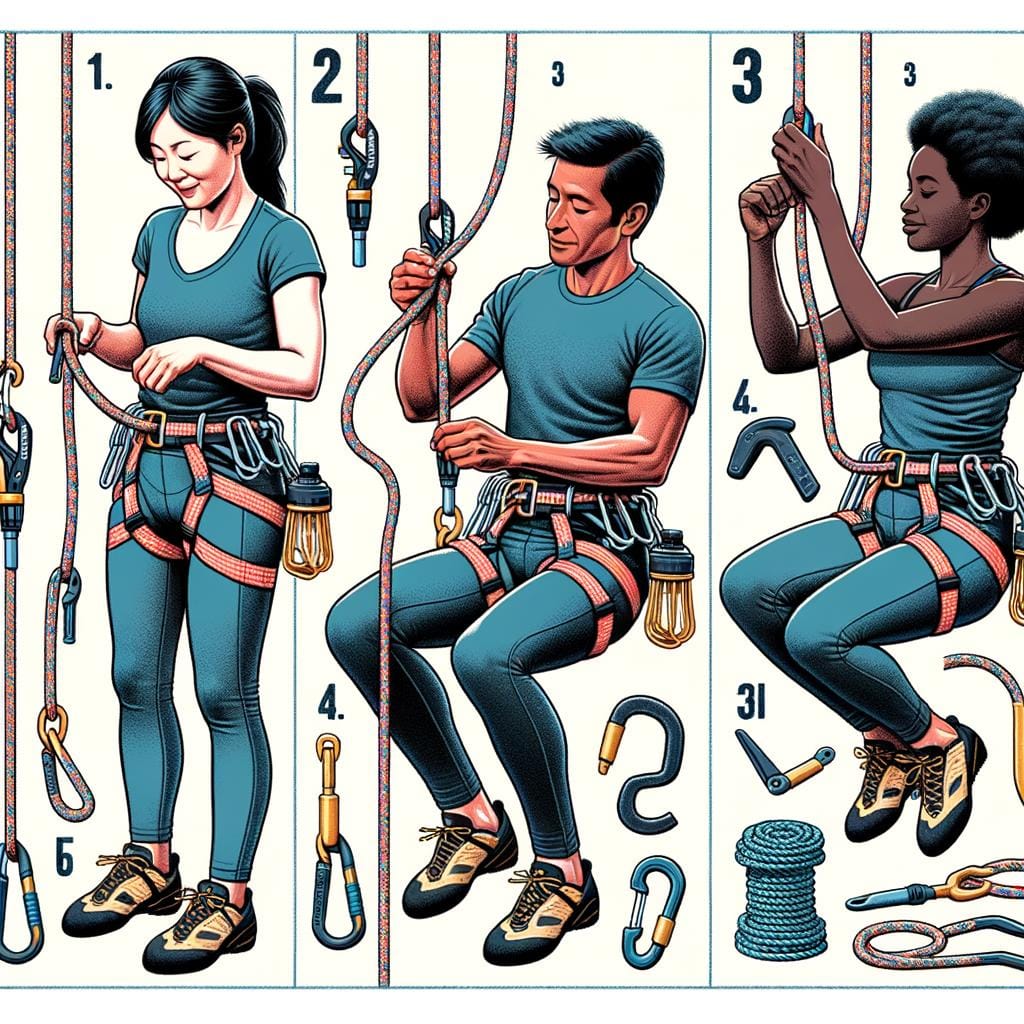Belay techniques are an essential component of rock climbing and other vertical activities, serving as a critical safety measure for both climbers and belayers. These techniques involve the proper use of ropes, harnesses, and belay devices to ensure that a falling climber can be safely caught and lowered to the ground.
In this article, we will delve into the world of belay techniques, exploring their significance in climbing, the various types of belay devices available, basic and advanced techniques for climbers of all levels, common mistakes to avoid, as well as safety tips and best practices.
Proper belay techniques play a crucial role in preventing accidents and injuries while climbing. By understanding how to effectively belay a climber, individuals can confidently support their partners during ascents and descents. Whether it’s top-roping on indoor walls or navigating multi-pitch routes outdoors, mastering belay techniques is fundamental for anyone engaging in vertical pursuits. The ability to securely manage rope systems can make the difference between a successful climb or a potentially dangerous situation.
Throughout this article, we will explore the different types of belay devices available on the market today and how they function to assist climbers and belayers. From traditional tube-style devices to modern assisted-braking devices, each tool comes with its unique features and benefits.
By familiarizing oneself with these devices and their functionalities, climbers can choose the most suitable option for their specific needs and preferences. So whether you’re a beginner looking to learn the basics or an experienced climber seeking to refine your skills, this comprehensive guide on belay techniques has got you covered.
The Importance of Proper Belay Techniques in Climbing
One key aspect of proper belay techniques is understanding the different types of belay devices available and how they work. Some common types include tubular devices, assisted braking devices, and figure-eight devices. Each device has its unique features and functions, but they all serve the same purpose of controlling rope tension to protect against falls. It is essential for climbers to choose the right belay device based on their climbing style, experience level, and specific needs.
In addition to choosing the appropriate belay device, climbers must also practice correct belaying methods to ensure a secure climbing experience. This includes properly tying knots, communicating effectively with your partner, maintaining constant vigilance while belaying, and reacting quickly in case of any unexpected situations. By following these guidelines and honing their skills through regular practice, climbers can significantly reduce the risk of accidents and injuries while enjoying their climbing adventures.
| Types of Belay Devices | Description |
|---|---|
| Tubular Devices | Commonly used for traditional lead climbing and rappelling. |
| Assisted Braking Devices | Provide extra friction for easier catching and holding falls. |
| Figure-Eight Devices | Suitable for beginners due to their simplicity and ease of use. |
Types of Belay Devices and How They Work
Belay devices are essential tools in rock climbing, providing climbers with a means to manage the rope while belaying their partner. There are various types of belay devices available, each offering different features and benefits. Understanding how these devices work is crucial for ensuring a safe and smooth climbing experience.
Here are some common types of belay devices along with a brief explanation of how they work:
- Tube-style Belay Devices: These popular devices, such as the ATC (Air Traffic Controller), use friction to control the rope. The climber’s brake hand pulls the rope through the tube, creating enough friction to slow or stop the descent.
- Assisted Braking Belay Devices: Examples include the GriGri and Mega Jul. These devices have a mechanism that automatically grabs onto the rope when sudden tension is applied, providing added security during falls.
- Auto-blocking Belay Devices: Devices like the Petzl Reverso function as both a belay device and rappel device. They feature horns or ears that allow for easier rope management during lowering or rappelling.
It is important for climbers to choose a belay device that suits their experience level, climbing style, and preferences. Additionally, proper instruction on how to use each type of belay device is crucial to ensure safety while climbing.
Basic Belay Techniques for Beginners
When starting out in the world of climbing, mastering basic belay techniques is essential for both the climber and the belayer’s safety. One of the fundamental techniques is the “PBUS” method, standing for Pull, Brake, Under, Slide. This technique involves pulling up slack, braking to stop a fall, keeping your brake hand under the belay device, and smoothly sliding down slack as needed. By following this method, beginner climbers can ensure a controlled and safe belay.
Another important aspect of basic belay techniques is understanding how to properly communicate with your climbing partner. Clear and concise communication can help prevent accidents and ensure a smooth climbing experience. Before starting a climb, agree on signals and commands to use during the ascent and descent. This will help both the climber and belayer stay in sync and anticipate each other’s movements.
It’s also crucial for beginners to familiarize themselves with different types of belay devices such as tubular devices or assisted-braking devices like Grigris. Each device has its unique features and ways of operation, so it’s important to understand how they work before using them. Additionally, practicing proper clipping techniques and tying knots securely are essential parts of basic belaying skills that beginners should focus on mastering.
| Basic Belay Techniques | Beginners |
|---|---|
| PBUS Method | Learn PBUS method for controlled belaying. |
| Clear Communication | Establish signals and commands for effective communication. |
| Belay Devices | Understand different types of devices like tubular or assisted-braking. |
Advanced Belay Techniques for Experienced Climbers
As climbers gain more experience and confidence in their abilities, they often seek to explore more advanced belay techniques to enhance their climbing skills. Advanced belay techniques go beyond the basic methods taught to beginners and require a greater level of proficiency and understanding of the intricacies involved in belaying. These techniques are crucial for climbers who want to tackle more challenging routes and push their limits in the sport.
One advanced belay technique that experienced climbers often utilize is dynamic belaying. This technique involves giving a dynamic belay, which means being able to effectively manage rope slack and tension as the climber moves up the route.
Dynamic belaying allows for a smoother ascent for the climber while also reducing the risk of falls by providing just enough give in the rope to absorb the impact of a fall without causing injury. It requires precise timing and coordination between the climber and belayer, making it essential for experienced climbers looking to elevate their climbing performance.
Another important advanced belay technique is lead belaying, which involves managing the rope for a lead climber as they ascend a route. Lead belaying demands a high level of skill and attentiveness from both the climber and belayer, as it requires constant communication, quick reactions, and precise control over rope management.
This technique is commonly used in lead climbing scenarios where the climber is placing protection along the route as they climb, presenting unique challenges that demand mastery of advanced belay techniques to ensure safety and success on challenging routes.
Incorporating advanced belay techniques into your climbing repertoire can significantly enhance your overall climbing experience by increasing efficiency, safety, and performance on more demanding routes. By mastering these techniques through practice, training, and guidance from experienced climbers or instructors, you can take your climbing skills to new heights while ensuring a higher level of safety during your climbs.
Remember that advanced belay techniques require patience, dedication, and a willingness to continually learn and improve in order to become a proficient and reliable belayer in any climbing situation.
Common Mistakes to Avoid When Using Belay Techniques
When it comes to climbing, belay techniques play a crucial role in ensuring the safety of both the climber and belayer. Proper belay techniques are essential for preventing accidents and injuries while climbing. However, there are common mistakes that climbers often make when using belay techniques that can compromise safety. By being aware of these pitfalls and avoiding them, climbers can improve their overall climbing experience.
Lack of Communication
One of the most common mistakes climbers make when using belay techniques is a lack of communication between the climber and belayer. Effective communication is key to ensuring a safe climbing experience. The climber should clearly communicate their intentions, such as when they are ready to climb or when they need a break. Likewise, the belayer should communicate any instructions or warnings to the climber, such as slack or tension needed in the rope.
Improper Use of Equipment
Another common mistake climbers make is improper use of belay devices and other equipment. It is important for climbers to fully understand how their belay device works and how to properly use it before hitting the crag. Using equipment incorrectly can lead to accidents and injuries. Climbers should always double-check their gear before starting a climb and seek guidance from experienced climbers if unsure about proper usage.
Distractions and Inattention
Distractions and inattention can also be detrimental when using belay techniques. It is crucial for both the climber and belayer to remain focused and attentive throughout the climbing process. Checking phones, having side conversations, or not paying attention to the climber’s movements can lead to mistakes that may compromise safety. Climbers should prioritize concentration on the task at hand to ensure a safe climb.
By being mindful of these common mistakes when using belay techniques, climbers can enhance their safety measures on the wall. Remembering the importance of communication, proper equipment usage, and attentiveness during climbs will contribute to a more enjoyable and secure climbing experience for all parties involved.
Safety Tips and Best Practices for Belaying
Always Double-Check Equipment
Before starting any climbing activity, it is crucial to always double-check your equipment. Inspect the ropes, harnesses, carabiners, and belay devices for any signs of wear or damage. Make sure everything is properly secured and functioning correctly before you begin belaying. Taking the time to check your gear can prevent accidents and ensure a safe climbing experience.
Communication Is Key
Clear communication between climbers is essential when belaying. Establishing verbal cues and signals with your climbing partner can help prevent misunderstandings and ensure a smooth climbing process. Discussing the route, signals for “on belay,” “climbing,” “slack,” and “belay off” are crucial for effective communication while belaying. Always confirm with your partner before you transition into different belay techniques or movements.
Stay Focused and Alert
Belaying requires full attention and focus on the climber at all times. Avoid distractions and stay alert to anticipate any potential risks or challenges that may arise during the climb. Being mentally present and engaged in the belaying process not only ensures the safety of the climber but also builds trust between both partners. Remember, staying focused is key to successful belaying experiences.
How to Master Belay Techniques Through Practice and Training
Belaying is a crucial skill in climbing that requires practice and training to master. By honing your belay techniques, you not only ensure the safety of your climbing partner but also enhance your overall climbing experience. Here are some key tips on how to improve your belay techniques through consistent practice and targeted training:
- Regular Practice Sessions: Dedicate time regularly to practice your belay techniques, both indoors and outdoors. This will help you build muscle memory and increase your confidence in handling different scenarios while belaying.
- Seek Professional Instruction: Consider enrolling in a belay course or hiring a certified instructor to provide personalized feedback on your technique. They can offer valuable insights and corrections to help you refine your skills.
- Utilize Simulation Exercises: Set up mock scenarios with fellow climbers to simulate challenging situations such as catching falls or lowering a climber safely. This hands-on practice will boost your proficiency in real-life climbing scenarios.
Training specifically for belaying is essential for climbers of all levels, whether you’re a beginner looking to establish a strong foundation or an experienced climber aiming to fine-tune advanced techniques. Remember that mastering belay techniques is an ongoing process that requires dedication and patience.
As you progress in your climbing journey, continue refining your skills through consistent practice and seeking opportunities for further training. By prioritizing the improvement of your belay techniques, you not only enhance the safety of yourself and others but also elevate the quality of your climbing experience overall.
Conclusion
In conclusion, mastering belay techniques is essential for climbers of all levels to ensure safety and success in their climbing endeavors. Whether you are a beginner just starting out or an experienced climber looking to enhance your skills, understanding the importance of proper belay techniques cannot be overstated. By using the right belay devices and practicing basic and advanced techniques, climbers can minimize risks and enjoy their climbing experiences to the fullest.
One key takeaway for improving your belay techniques is to always prioritize safety above all else. This means double-checking your gear, communicating effectively with your partner, and staying vigilant throughout the entire climbing process. Remembering common mistakes to avoid, such as improper rope management or distractions while belaying, can go a long way in preventing accidents and ensuring a smooth climbing experience.
Lastly, consistency in practice and training is crucial for mastering belay techniques. By dedicating time to honing your skills on a regular basis, climbers can build confidence and proficiency in using different belay devices and techniques. Whether indoors at a climbing gym or outdoors on real rock faces, committing to improving your belay techniques will not only make you a better climber but also contribute to a safer and more enjoyable climbing community overall.
Frequently Asked Questions
What Are the 4 Steps of Belay?
The 4 steps of belay involve the belayer communicating with the climber, taking in slack as the climber ascends, providing a soft catch in case of a fall, and lowering the climber safely back down. These steps are crucial for a safe climbing experience.
How Do You Belay Effectively?
Belaying effectively requires attentiveness, clear communication with the climber, proper use of belaying devices, quick reaction time in case of a fall, and ensuring that the rope is always properly secured and managed. It’s important for both the belayer and climber to be on the same page.
What Was the Old Belay Technique?
The old belay technique involved simply wrapping the rope around one’s waist or body to create friction when catching a falling climber. This method was less secure and more prone to mistakes compared to modern belaying techniques using specialized devices like ATCs or Grigris.

An avid outdoor enthusiast, writer, and environmental advocate who has spent over two decades exploring the world’s most breathtaking landscapes. With a background in environmental science and a passion for adventure, Frances combines her love for nature with her talent for storytelling to inspire others to embark on their own outdoor journeys.




